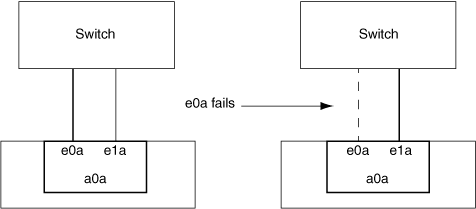Characteristics of single-mode interface groups
In a single-mode interface group, only one of the interfaces in the interface group is active. The other interfaces are on standby, ready to take over if the active interface fails.
Characteristics of a single-mode interface groups:
For failover, the cluster monitors the active link and controls failover.
Because the cluster monitors the active link, there is no switch configuration required.
There can be more than one interface on standby in a single-mode interface group.
If a single-mode interface group spans multiple switches, you must connect the switches with an Inter-Switch link (ISL).
For a single-mode interface group, the switch ports must be in the same broadcast domain.
Link-monitoring ARP packets, which have a source address of 0.0.0.0, are sent over the ports to verify that the ports are in the same broadcast domain.
The following figure is an example of a single-mode interface group. In the figure, e0a and e1a are part of the a0a single-mode interface group. If the active interface, e0a, fails, the standby e1a interface takes over and maintains the connection to the switch.
